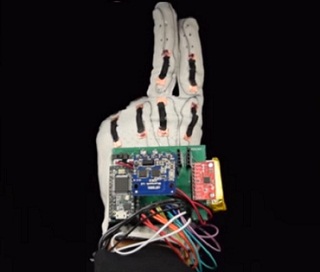
Researchers have created this smart device using a leather athletic glove and stretchable sensors.
Scientists at the University of California San Diego (UCSD) have developed a smart glove, dubbed the “The Language of Glove” that can easily translate sign language into text wirelessly. Scientists have created this glove using stretchable and printable electronics that are available commercially, and it costs less than US$100. According to its developers, the glove can be used to control objects in virtual reality games, and can translate all 26 letters of the American Sign Language (ASL) alphabet into text.
Design of the smart glove
The UCSD researchers created this smart device using a leather athletic glove and stretchable sensors. There are nine sensors used in the glove, and these sensors are adhered to the back at the knuckles. Each finger has two sensors while the thumb has one sensor. The sensors are made of a stretchable material—basically a silicon-based polymer that is coated with conductive carbon paint. A copper tape secures sensors onto the gloves. The sensors are also connected to a printed circuit board through a stainless steel thread.
Working of the smart glove
When sensors are bent or stretched, a change in their electrical resistance occurs. Based on the position of the sensors, a code is generated for different letters of the ASL alphabet. The code for a straight knuckle is “0” while the code for a bent knuckle is “1.” In this way, nine sensors generate a nine-digit binary key, which is translated into a particular letter with the help of the printed circuit board. For example, the code “011111111” (all fingers curled and thumb straight) refers to letter “A” while code “100000000” means letter “B”. The signal of the letter is transmitted to a smartphone or computer screen wirelessly with the help of a Bluetooth device.
The glove is simple to make and is inexpensive. The team is hopeful that their work would allow other researchers to design similar smart wearable devices using low-cost materials and a straightforward design.
According to Timothy O’Connor, a PhD student at the University of California San Diego, they aim to create a new version of the smart glove that will come with a sense of touch and will let people use their hands in virtual reality. This smart glove will be more intuitive than all existing controllers currently used in games and entertainment. Moreover, it will be used in a variety of other applications including virtual training procedures (simulating the use of one’s hands) in medicine field.
